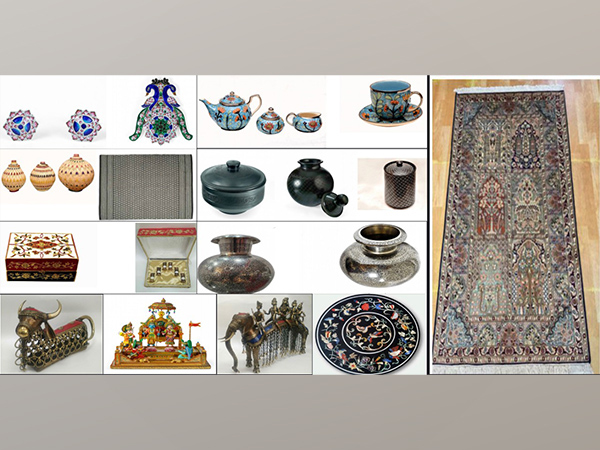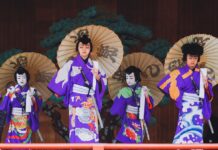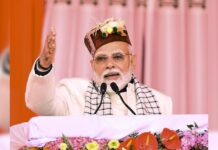SCHLOSS ELMAU: Prime Minister Narendra Modi, who was on a visit to Germany to attend G7 Summit, presented its leaders with various gifts displaying India’s rich art and crafts, particularly, those related to Uttar Pradesh’s one district one product scheme
His gifts included a hand-knotted carpet, carved matka, itr bottles, tea set, brooch and cufflinks.
PM Modi gifted a Metal Marodi carving matka to German Chancellor, Olaf Scholz. This nickel-coated, hand-engraved brass vessel is a masterpiece from District Moradabad, which is also known as the Peetal Nagari or “brass city” of Uttar Pradesh, India. After casting the pot, the design that has to be engraved is first sketched on paper. An outline of the whole design is done with a fine engraving tool hammered with a wooden block. This particular type of engraving is called Marodi, owing to the curved lines used to fill up negative space in this design.
He gifted Gulabi Meenakari brooch and cufflink set to US President, Joe Biden. Gulabi Meenakari is a GI-tagged art form of Varanasi in Uttar Pradesh. A piece of pure silver is moulded into a base form, and the chosen design is embossed in the metal. The embossed shapes are then filled with great dexterity with crushed meena glass mixed with an intriguing natural anardana (pomegranate seeds) glue.
The paint is fired layer by layer for permanence. The motifs primarily use the colour pink (Gulabi), which lends its name to the craft. These cufflinks were prepared for the President with a matching brooch for the First Lady, Jill Biden.
Prime Minister Modi gifted a platinum-painted, hand-painted tea set from Bulandhshahr, Uttar Pradesh to UK PM Boris Johnson. The crockery is outlined with platinum metal paint in honour of the Queen’s platinum jubilee being celebrated this year.
The base form is hand-painted and fired at 1200 degrees Celsius. The embossed outlines are laid on manually with Mehndi cone work and require an extremely confident hand. Each shape is then separately filled with colour, with great dexterity and the entire cup is fired again.
To French President Emmanuel Macron, PM Modi gifted Itr bottles in Zardozi box. The carrier box has been crafted in Lucknow, the capital city of Uttar Pradesh, India. The zari zardozi box has been hand embroidered on khadi silk and satin tissue in colours of the French National Flag. The motifs are traditional Indo-Persian, lotus flowers hand-embroidered with metal wire in blue and a pendant used in Kashmiri carpets and motifs from Awadhi architecture.
This box included Attar Mitti, Jasmine oil, Attar Shamama, Attar Gulab, Exotic Musk, and Garam Masala.
PM Modi gifted hand-knotted silk carpets which are famous all over the world for their softness and craftsmanship to Canadian PM Justin Trudeau.
A Kashmiri Silk carpet is known for its beauty, perfectness, lushness, luxury and dedicated craftsmanship. Each Kashmiri Silk carpet is considered to be a never-before-seen piece of hand-made art. The Kashmiri silk carpets are made predominantly in the Srinagar area of the Union Territory of Jammu & Kashmir in India.
These exquisite creations are hand-knotted on the warp threads, one at a time, in accordance with a strict code of colours in the order of their appearance in the pattern. The knotted product is clipped with shears to smoothness and then treated with several brightening processes.
Characteristically, all silk carpets have an amazingly innate attribute of displaying different colours when viewed from different angles or sides.
PM Modi gifted Black Pottery pieces to Japan’s PM, Fumio Kishida. The Black Pottery of Nizamabad in Uttar Pradesh uses a special technique to bring out black colours- while the pottery is inside the oven, it is ensured that there is no scope for oxygen to enter the oven and the heat level remains high. The presence of oxygen can turn the pottery red. The glaze on the pottery comes from the high zinc content of the soil and the layer of mustard oil applied before firing the pottery.
PM Modi gifted a marble inlay table top to Italy’s PM, Mario Draghi. Pietra dura or Marble inlay has its origins in the Opus sectile- a form of pietra dura popularized in the ancient and medieval Roman world where materials were cut and inlaid into walls and floors to make a picture or pattern. This marble table top with Inlay work has its origin in Agra of Taj Mahal fame.
This particular table top is made of semi-precious stones with gradients in their colour, making it very similar to Italian marble inlay work. Stones with colour gradients are harder to place, but make the inlay more realistic.
The delicate process involves cutting and engraving semi-precious stones on marble manually. To start with, a pre-defined pattern e.g., a floral design or a geometrical design, is engraved on the marble item. Small pieces of different semi-precious stones are then cut delicately. These small pieces are then slipped into grooves, making the simple marble item a beautiful and colourful masterpiece of art.
Other than G7 leaders from Canada, France, Germany, Italy, Japan, the United Kingdom and the United States, as well as the European Union, PM Modi also gifted items to leaders from Indonesia, South Africa, Senegal and Argentina.
The Prime Minister gifted Dokra Art with Ramayana Theme to South Africa’s President, Cyril Ramaphosa. Dokra Art is non-ferrous metal casting art using the lost-wax casting technique. This sort of metal casting has been used in India for over 4,000 years and is still used. There are two main processes of lost wax casting: solid casting and hollow casting. The product of artisans who are mainly from Central and Eastern India are in great demand in domestic and foreign markets because of their primitive simplicity, enchanting folk motifs and forceful form.
This particular art piece from Chattisgarh, a state in Central India, is based on the Ramayan theme. The principal characters in the artwork are Lord Shri Ram riding an Elephant along with Lakshman, Goddess Sita and Lord Hanuman.
PM Modi gifted Nandi-themed Dokra Art to Argentina’s President, Alberto Fernandez. Dokra Art is non-ferrous metal casting art using the lost-wax casting technique. This sort of metal casting has been used in India for over 4,000 years and is still used. There are two main processes of lost wax casting: solid casting and hollow casting. The product of artisans who are mainly from Central and Eastern India are in great demand in domestic and foreign markets because of their primitive simplicity, enchanting folk motifs and forceful form.
This particular art piece from Chattisgarh, a state in Central India, is a figure of ‘Nandi – The Meditative Bull’. According to Hindu mythology Nandi is considered as the vehicle (mount) of Lord Shiva, the lord of destruction. In front of every Shiva temple, on the court facing the shrine, you can see the image of a Nandi.
PM Modi gifted Moonj baskets and cotton durries to Senegal’s President, Macky Sall. Moonj is a wonderful example of utilitarian handicrafts made with sustainably sourced material. Like Senegalese baskets, Moonj craft also utilizes bright, jewel-tone colours. This particular piece is by a master craftswoman from Prayagraj. The blades of the sarpat grass used here are much thinner, making them more difficult to weave.
The cotton Durries are hand woven in the Sitapur district of Uttar Pradesh. The art of Manjak loincloth weaving is similar to shuttle handloom work done in Sitapur durrie making. The beauty of this particular piece is the thin width of its loom which increases the work out into the Durrie threefold.
PM Modi gifted lacquerware Ram Durbar to Indonesia’s President, Joko Widodo. The GI-tagged lacquerware art-form has its roots in the temple town of Varanasi in Uttar Pradesh. The wooden statues of gods, goddesses and sacred animals served as coveted souvenirs taken back by pilgrims. The process is a tedious one, requiring assembly of a base wooden form with separate limbs, which is covered layered by layer with distemper or lac-based paint. True to their city of origin, Lacquerware items always come in bright, jewel tones.
This particular piece is made on Goolar (Botanical name: Ficus Racemosa) wood. The principal characters in the artwork are Shri Ram, Goddess Sita, Lord Hanuman and Jatayu. It is believed that the Indonesian version of Ramayana was written during the Medang Kingdom (732-1006 AD) in Central Java. It is known as Kakawin Ramayana. The story of Ramayana was narrated to the people through shadow puppetry (wayang kulit and wayang purwa). (ANI)







